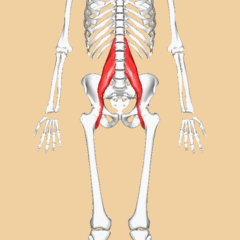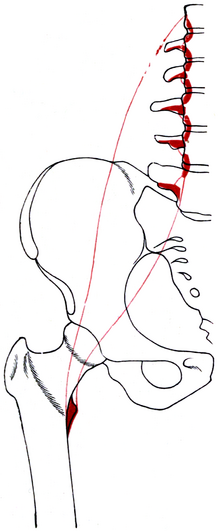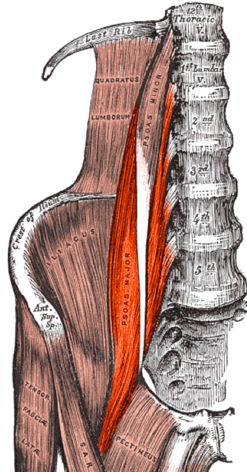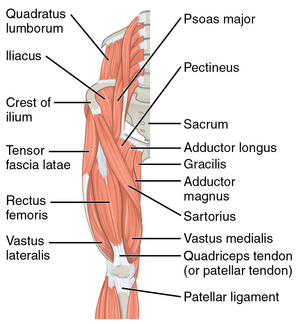Psoas Major
Original Editor - Oyemi Sillo
Top Contributors - Vidya Acharya, Samrah khan, Lucinda hampton, Oyemi Sillo, Kim Jackson, George Prudden, Samson Chengetanai, Joao Costa, Maram Salem, Rachael Lowe and Kardelen Aktas;
Description[edit | edit source]
The psoas muscle is a low back muscle located deep in the body, very close to the spine and the brim of the lesser pelvis. At its distal end, it combines with the iliacus muscle to form the iliopsoas muscle. This depth, combined with the fact that the psoas originates from the sides of the five lumbar vertebrae, means it plays an important role in back health.
- It also acts to both laterally flex the lumbar spine as well as stabilize and flex the thigh.[1] [2]
- It is essential for correct standing or sitting lumbar posture, stability of the hip joint, and during walking and running[3].
Anatomy[edit | edit source]
Origin
The psoas muscle is anatomically considered to have superficial and deep parts owing to the presence of branches of the lumbar plexus running through it. Superficial part - overlies the lumbar plexus and takes origin from the sides of the T12 and L1 to L4 vertebrae including the intervening intervertebral discs. The deep part which lies mainly deep to the branches of the lumbar plexus takes origin from the transverse processes of lumbar vertebrae L1 to L5.
Insertion
The fibres of the muscle converge from its wide origin as they descend on the posterior abdominal wall, They cross the pelvic inlet/brim to form a long tendon, which is joined within the pelvic region by multitudinous fibres from the iliacus muscle, finally inserting into the lesser trochanter of the femur.
Nerve Supply
Branches from the ventral rami of lumbar spinal nerves (L1, L2, and L3) before they join to form the lumbar plexus.
Blood Supply
The muscle receives blood from the four lumbar arteries from the aorta, from small branches of the renal arteries, from small muscular branches of the common iliac artery, and from the deep circumflex iliac artery[4].
Action and Function[edit | edit source]
The psoas major muscle
- Stabilizes the lumbar spine during the sitting position
- Flexion of the thigh in a supine position or standing.
- Acts as a stabilizer of the femoral head in the hip acetabulum in the first 15 degrees of movement.[3]
- To connect the upper body to the lower body, the outside to the inside, the appendicular to the axial skeleton, and the front to the back, with its fascial relationship.
- Combined with the iliopsoas muscle, the psoas is a major contributor of flexion of the hip joint.
- Unilateral contraction of the psoas also helps with lateral motions and bilateral contraction can help elevate the trunk from the supine position.
- The psoas muscle also works in conjunction with the hip flexors to elevate the upper leg towards the body when the body is static or pull the body towards the leg when the leg is in a fixed position.[1]
Video[edit | edit source]
A good 2 and 1/2 minute video on the anatomy of the psoas major.
Physiotherapy Relevance[edit | edit source]
When your psoas muscle gets too tight or shortened, it may arched back ie lumbar hyperlordosis, especially if the abdominal muscles are challenged eg in sit up.
If the psoas is weak, it will likely be harder to flex the hip joint, negatively affect the ability to climb stairs, walk uphill, get up from supine or preparing to stand up from a sitting position[2].
See also
- Iliopsoas Tendinopathy
- Iliopsoas Bursitis
- Lower Crossed Syndrome
Related links[edit | edit source]
References[edit | edit source]
- ↑ 1.0 1.1 Radiopedoa Psoas Major Available: https://radiopaedia.org/articles/psoas-major-muscle-1?lang=us(accessed 16.1.2022)
- ↑ 2.0 2.1 Very well health Psoas Muscle and Your Low Back Health Available:https://www.verywellhealth.com/psoas-muscle-and-your-low-back-health-297061 (accessed 16.1.2022)
- ↑ 3.0 3.1 Bordoni B, Varacallo M. Anatomy, Bony Pelvis and Lower Limb, Iliopsoas Muscle. StatPearls [Internet]. 2021 Jul 21. Available:https://www.ncbi.nlm.nih.gov/books/NBK531508/ (accessed 16.1.2022)
- ↑ http://www.wheelessonline.com/ortho/psoas










